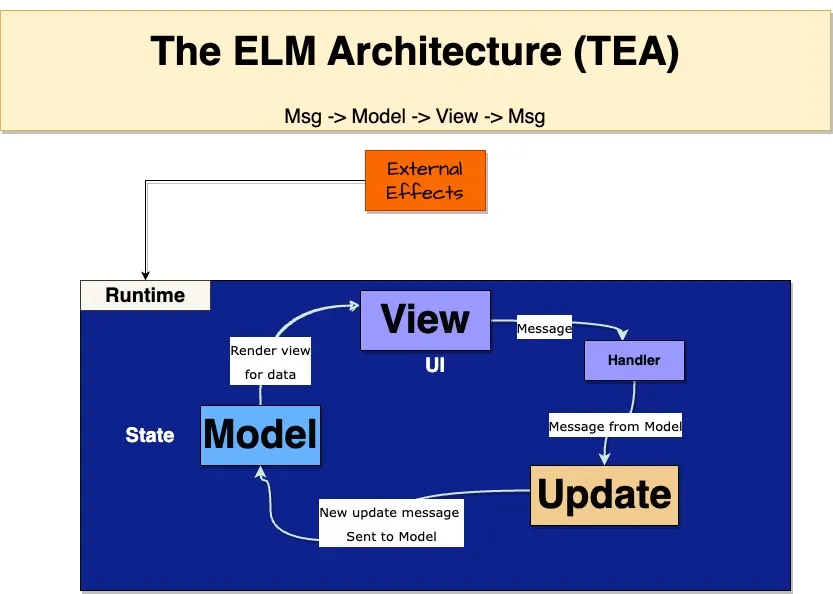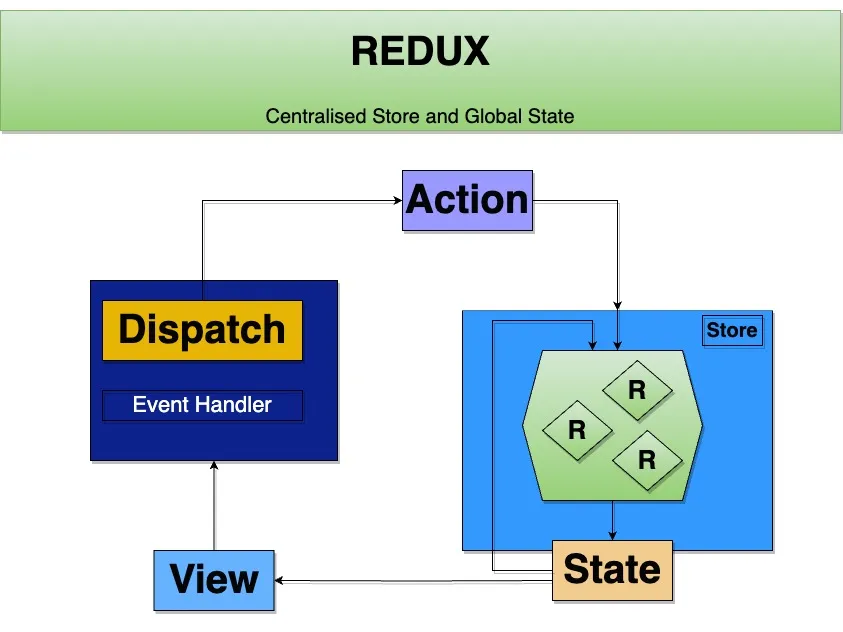Getting Started with The Composable Architecture (TCA)
This article will help in understanding the Swift—Composable Architecture and how it benefits SwiftUI Apps efficiently.

The Composable Architecture (TCA)
Overview of TCA
Brendan Williams and Stephen Celis are the brilliant minds behind TCA, showcasing their innovation in software architecture.
Drawing inspiration from the well-regarded paradigms of ELM and Redux, TCA has firmly established itself as a notable player in the realm of software development.
Let’s dive into TCA’s key offerings, which comprise
an Opinionated Library tailored for app development
a Multi-Store Architecture
an Unidirectional Flow pattern
an efficient method for managing Side Effects.
The term ‘Composition’ itself hints at the process of breaking down complex functionalities into smaller, modular units that can be easily combined. Reducer builders and operators, like Scope, offer a robust solution for handling complex features and promoting modularization within software projects
ELM Architecture
The architecture flow of ELM, a functional programming framework for web applications comprises View, Update, and Model stages. Model stores app state, Update handles data changes via messages, and View produces the UI based on the current state.
REDUX
On the other hand, we have a popular state management pattern for JavaScript applications.
Redux introduces a centralized store to manage the application’s state. The process begins with the Action phase — Actions describe state changes. Reducers define how the state changes based on actions. The Store stores the state. After the Redux cycle, integrating View with React, where components dispatch actions to change the state.
Framework Integration In terms of Framework Integration to our Xcode project, the TCA has supported only Swift Package Manager (SPM).
About TCA
They have started building this framework in the year 2019 and released their first version on May 4th 2020. Open source framework and also supported widely by the community.
Integration
To Integrate the framework, we need to add packages to our project and add their repo URL to get the packages.
Latest Version — 1.17.1
Open source and supported widely by the community
To install the SDK through Swift Package Manager:
💡
In Xcode, select File > Add Package and enter https://github.com/pointfreeco/swift-composable-architecture as the repository URL
About TCA
TCA is a little more Opinionated library compared to ELM and Redux architectures. Side Effect: Event modifies App State from outside or External Change. Hence the Debugging will be tough.
State Management — Behaves for different state value
Composition — Divide and Conquer — well-defined, isolated modules
Testing — Testing the mini modules
Ergonomics — Framework Provides convenient APIs to implement the components
Before we dive into the TCA flow, let’s establish some fundamental concepts of Swift UI.
SwiftUI
SwiftUI — Declarative UI As we are well acquainted, SwiftUI is built upon the Declarative UI paradigm.
In UIKit, there exists a disparity between the App State and the View State. These can be altered independently, leading to a loss of synchronization.
App State is inconsistent with View State Losing Synchronization However, in the realm of SwiftUI, the App State remains consistent and synchronized.
Synchronization App State is consistent State rules everything
💡
UI = fn(State)
SwiftUI - Flow
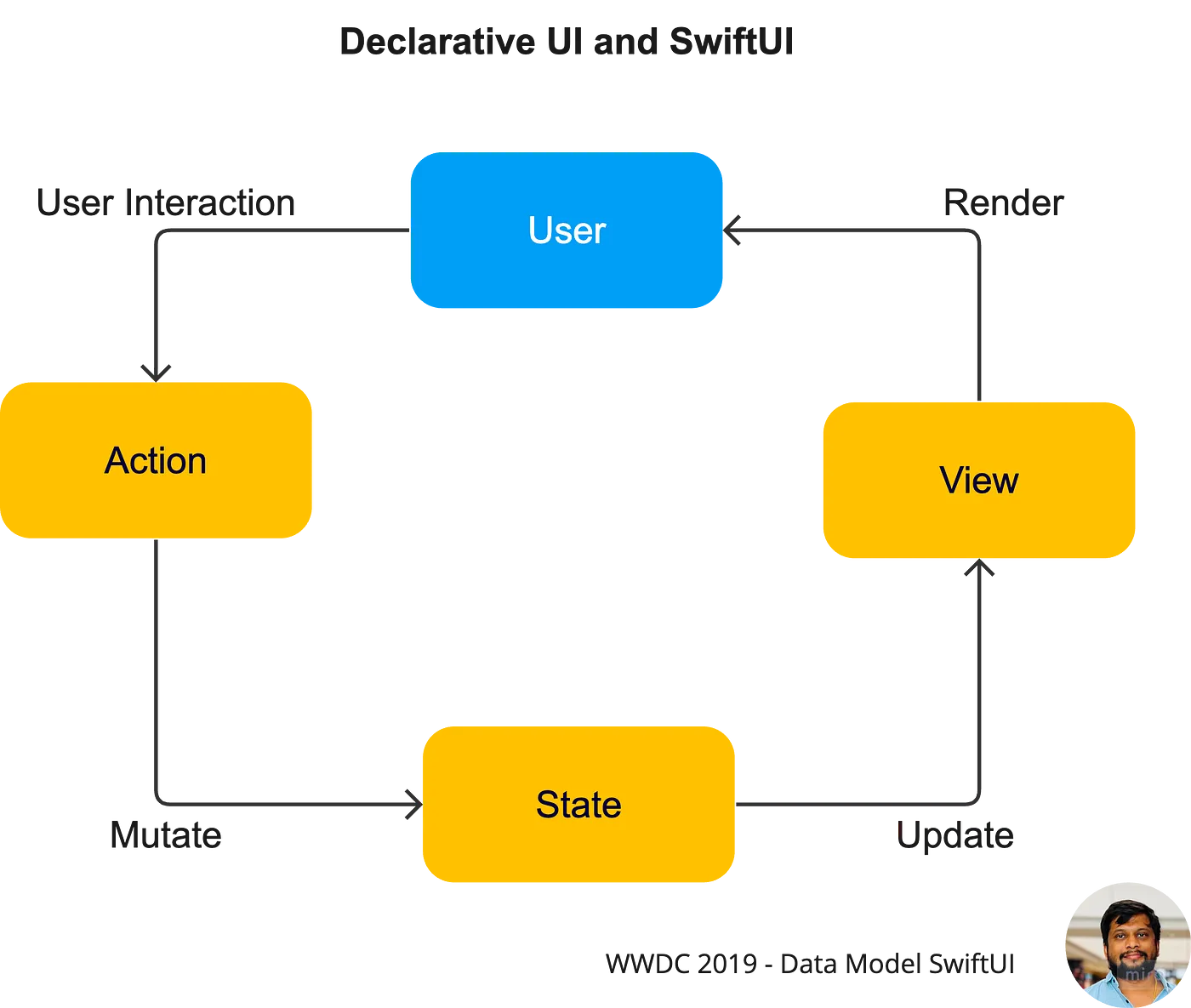
Data Flow - SwiftUI
Drawing from the SwiftUI Data Model presented at WWDC 2019, it becomes evident that Views are a result of state, rather than a sequence of events.
When users engage with the app through actions, the state undergoes mutation.
Following this transformation, the state update triggers a need for a View update, directly tied to the state’s alterations.
This process guides the View to generate an updated version of the UI, aligned with the current state.
Unidirectional Flow
The powerful unidirectional flow adopted by The Composable Architecture (TCA) in Swift. TCA’s implementation of unidirectional flow simplifies app development, making it more predictable and easier.
The unidirectional flow in TCA begins with the Action phase. These actions represent user interactions, such as button presses or text input.
Let’s discuss about Unidirectional Flow

Unidirectional Flow with single reducer
The Composable Architecture adopts the unidirectional flow.
Unidirectional Flow is the way to mutate the State, we need to send Actions to the ViewStore which is also called a runtime store.
The store holds all business logic and is responsible for mutating.
Reducer comes into the picture and handles action which is the boilerplate.
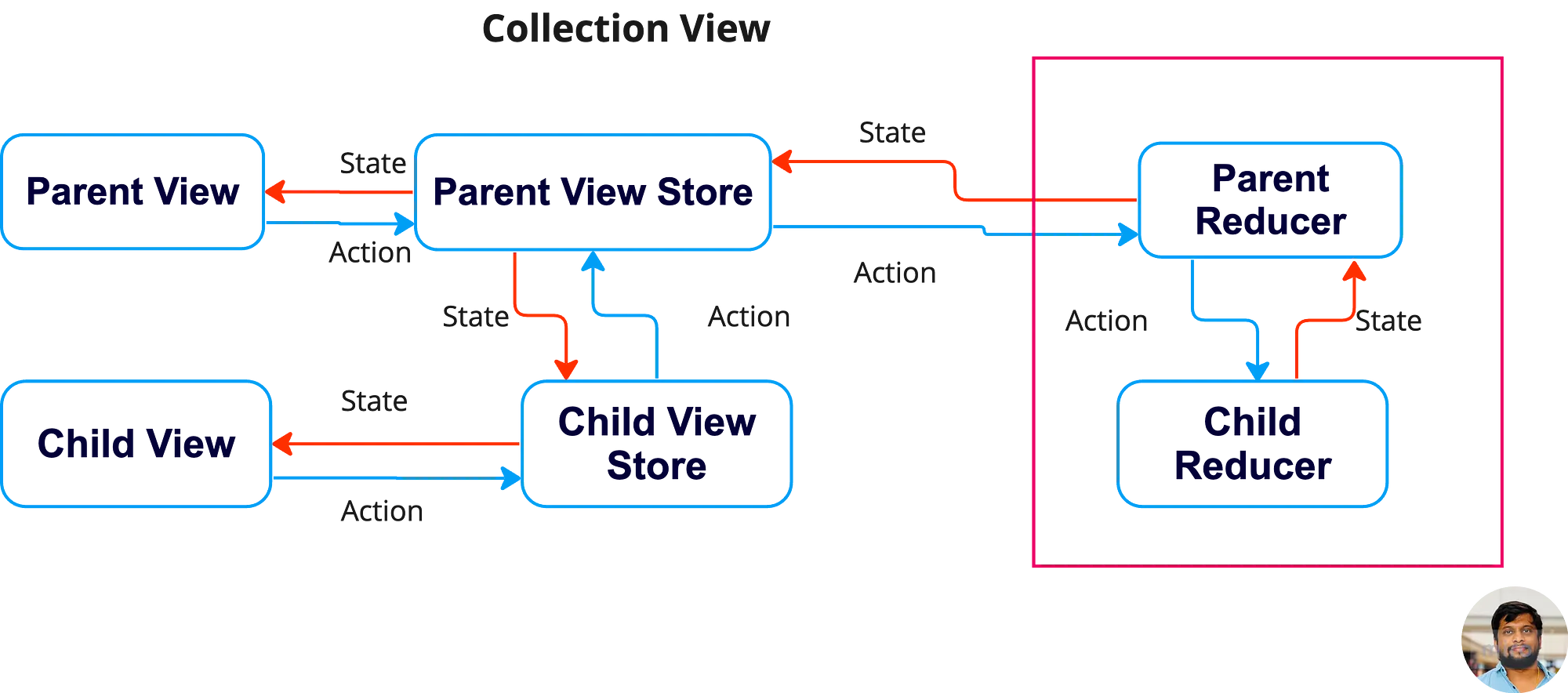
Unidirectional Flow with multiple reducers
In TCA, these flows show how state and action are chained together and how they flow between single View and collection View
Since TCA allows unidirectional data flow, you can always access the child state from the parent reducer.
Deep Dive into TCA Architecture
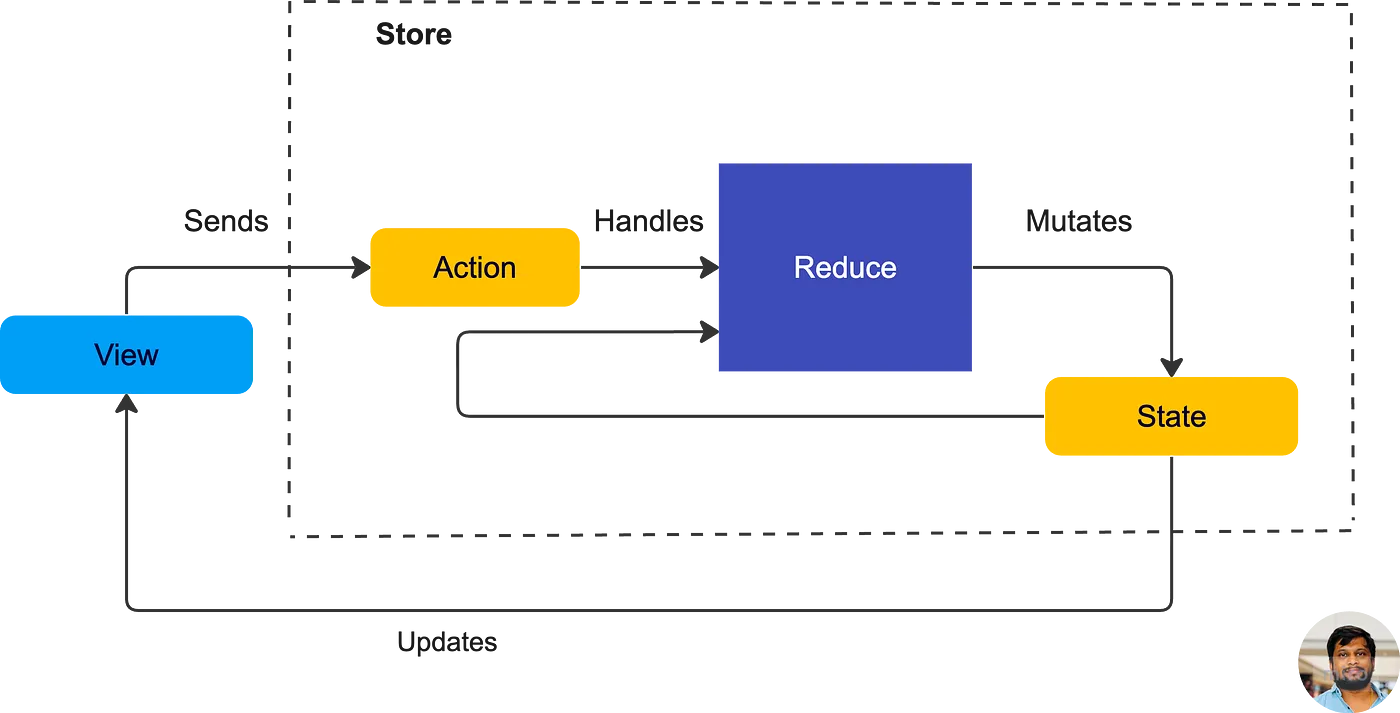
TCA Architecture Flow Diagram
View sends the action can be of any events such as onAppear or fetch API service data
Reducer function is the pure function taking the current state and action as input, producing a new state. This is called a Mutation. This flow happens in the unidirectional flow with the help of Store.
Following the transformations, the state update triggers a need for a View update.
State represented as a structure, Action as enums, Reducer — pure function. This Unidirectional Flow happens in the runtime store that is called a Store.
Building Blocks
State represents the entire UI state of a feature/module. Single source of truth for the UI
Action represents user intents or events in a declarative manner You can take examples such as Examples: Button tapped, data fetched, text entered
Reducer is the heart of TCA — responsible for state transitions. Pure function takes the current state and action as input, producing a new state.
Effect represents side effects, like asynchronous tasks (network requests, etc.)
Store manages the state, actions, and reducers. As TCA adopts the unidirectional data flow, Actions trigger state changes through reducers.
Dependencies required for actions and effects
Let’s take a look at the implementation part. Here we will use the CurrencyConverter App.
State
State is a value type that describes the entire UI state of a feature/module. It’s a single source of truth for the UI. Changes in the UI are a result of changes in the state. Must needed for logic and UI. This provides the application’s initial state and a collection of properties.
A single way to mutate the state by dispatching actions to the store which holds the state
State represented as Structure and it conforms to the Equatable protocol. You can see this as an example with a property.
struct State: Equatable {
var initialCurrencies: Currencies = []
var currencies: Currencies = []
var priceQuantityEntered = "1"
var selectedBaseCurrency: String = "EUR"
}State - Single Source of truth for UI
Action
Actions represent user intents or events in a declarative manner. Value types that describe what the user wants or what has happened. Examples: Button tapped, data fetched, text entered.
enum Action: Equatable {
case onAppear
case processAPIResponse(CurrencyData)
case quantityTextFieldEntered(String)
case countryCodePickerSelected(String)
case updateCurrencies(Currencies)
}Action - Cases - User Events
Reducer
Reducer is the heart of TCA and pure function. Reduce into function is the more primitive version that involves implementing all of the logic for the feature directly in this method. Pure Function transforms the current state to the next state and it determines how the state changes based on the current action
It is also responsible for returning any Effects that should be run such as API requests by returning an Effect value.
var body: some ReducerOf<Self> {
Reduce{ state, action in
switch action {
case .onAppear:
return .run { send in
let (data, _) = try await URLSession.shared.data(from: URL(string: "https://pastebin.com/raw/Nq1KvHjZ")!)
let currencyData = try JSONDecoder().decode(CurrencyData.self, from: data)
await send(.processAPIResponse(currencyData))
}
case let .processAPIResponse(data):
let cuurencies = getTableViewDataArray(currencyListView: data)
state.initialCurrencies = cuurencies
return .send(.updateCurrencies(cuurencies))
case let .updateCurrencies(currencies):
state.currencies = currencies
return .none
case let .quantityTextFieldEntered(string):
state.priceQuantityEntered = string
print(string)
return .send(.updateCurrencies(reactToEnteredAmount(state: state, amount: Double(string) ?? 1.0)))
case let .countryCodePickerSelected(currencyCode):
state.selectedBaseCurrency = currencyCode
return .none
}
}
}API Requests Example with Reducer
The body style of defining a reducer is more “high level”. You don’t directly perform any of the mutation or effect logic in the body and instead, you compose many other reducers together, similar to how SwiftUI views work.
Let’s move into the View Part
import SwiftUI
import ComposableArchitectureimport statements
Store
Store is a runtime that drives the feature. It sends all user actions to the store so that it can run the reducer and effects, to observe state changes in the store. From this, we can able to update the UI.
Operators such as:
Scope — break stores into smaller ones
Combine — combine two or more reducers into a single reducer
WithViewStore
Initializes a structure that transforms a “Store” into an observable ViewStore in order to compute views from the state.
let store: StoreOf<CurrencyConverter>
StoreOf<R: Reducer> = Store<R.State, R.Action>
WithViewStore(self.store, observe: { $0 }) { viewStore in
}Transforms Store to ViewStore
Observe — Pass a closure that describes what state you want to observe. This gives a trailing closure and hands a ViewStore
var body: some View {
WithViewStore(self.store, observe: { $0 }) { viewStore in
VStack {
HStack {
TextField(
"Enter text",
text: viewStore.binding(
get: \.priceQuantityEntered,
send: { .quantityTextFieldEntered($0) }
)
)
.keyboardType(.numberPad)
.textFieldStyle(.roundedBorder)
.padding()
Spacer()
Picker("Currency",
selection: viewStore.binding(
get: \.selectedBaseCurrency,
send: { .countryCodePickerSelected($0) })
) {
ForEach(viewStore.currencies) {
Text($0.currencyCode)
}
}
.pickerStyle(.menu)
}
Spacer()
List(viewStore.currencies) { tableViewData in
CurrencyRowView(tableViewData: tableViewData)
}
}
.onAppear {
viewStore.send(.onAppear)
}
}
}Observe with viewStore
I hope you like this overview of The Composable Architecture (TCA). There are other benefits such as NavigationStack, HigherOrderFunctions, and Effects with Timers.
Additionally, it also supports Concurrency, Testing and domain-specific languages.
Effect
Effect — Decoupled from reducers to keep logic clean and testable. The effect can result in the Reducer function. Dispatched by reducers, run asynchronously, and can produce new actions. Effect represented as a struct. The reducer function returns to the effect.
#Declaration
struct Effect<Action>
#Implementation:
func reduce(into state: inout State, action: Action) -> Effect<Action> {
}Reduce — Effect
Environment
Environment — Provides dependencies required for actions and effects. Example — API Clients, random number generators.
Makes testing easier by injecting mock dependencies.
@Dependency(\.continuousClock) var clockDependency Example
Comparison with other architectures
The era of Declarative UI (SwiftUI) — Composable architecture is required
Easy to make UI components and combine/compose the components
The benefits of Declarative UI can be maximized.
Multi-Platform — Supports SwiftUI on iOS, WatchOS, MacOS
Modularity in working with teams and reusing the modules
Pure Function Reducer — low boilerplate compared to VIPER
Consistency and Testable compared to MVVM + Coordinator
Protected against unexpected side effects and handling
Benefits
Isolation — Isolated local stores and states
Composition — Composition of mini-Modules
Pure Functions — Uses pure functions(Reducer Functions) to update the State
Managing side effects — Functions are executed by the runtime system and produce new actions
SPONSOR

The Unique iOS Swift Conference in the UK
SwiftLeeds is a premier iOS conference taking place on October 7-8 this year. If you’re looking to stay updated on the latest trends in iOS development and connect with like-minded professionals, this event is a must-attend! Don’t miss out—book your tickets now!
Get your tickets!Shortcoming
Learning about composable architecture can be challenging for new developers due to its steep learning curve.
Frequent changes in the library require preparation for implementation in the project.
Complexity in Integration and not the drag-and-drop solution.
Note
Please find the GitHub Repo
On September 2023, I gave a speech about this topic at a SwiftBlr meetup.
This is a free third party commenting service we are using for you, which needs you to sign in to post a comment, but the good bit is you can stay anonymous while commenting.
